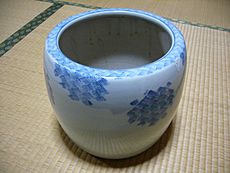Hibachi facts for kids
The hibachi is a special heating device from Japan. It's like a bowl or box that holds burning charcoal to keep people warm. People believe hibachis have been used for a very long time, possibly since the Heian period (which was from 794 to 1185).
Contents
What is a Hibachi?
A hibachi is a container, usually round, cylinder-shaped, or box-shaped. It's made from materials that can handle heat. Inside, it's filled with ash, and the charcoal sits right in the middle of the ash. To move the hot charcoal around, people use special metal chopsticks called hibashi. These are similar to the tongs you might use for a fireplace.
How Hibachis Work
Originally, hibachis were mostly used for heating, not for cooking. They warm things up by sending out heat, a bit like how a warm oven makes your kitchen feel cozy. However, a hibachi isn't strong enough to heat a whole room. Sometimes, people would place an iron kettle called a tetsubin on top of the hibachi to boil water for tea. Later, around the 1900s, some people started doing a little bit of cooking on them too.
Safety First!
Old Japanese houses often had lots of fresh air coming in. This meant that dangerous gases like carbon monoxide from burning charcoal were less of a worry. However, it's still very important to use hibachis carefully. They should never be used in small, closed-off rooms, especially in modern buildings that are very well sealed. Always make sure there's plenty of fresh air when using any charcoal heater.
Hibachi in North America
In North America, the word hibachi often means something different. It can refer to a small cooking grill that uses charcoal, which is actually called a shichirin in Japan. Or, it can mean the large iron griddle (called a teppan in Japan) used in teppanyaki restaurants, where chefs cook food right in front of you.
Images for kids
-
An old hibachi from before the Edo period (1600–1868)






